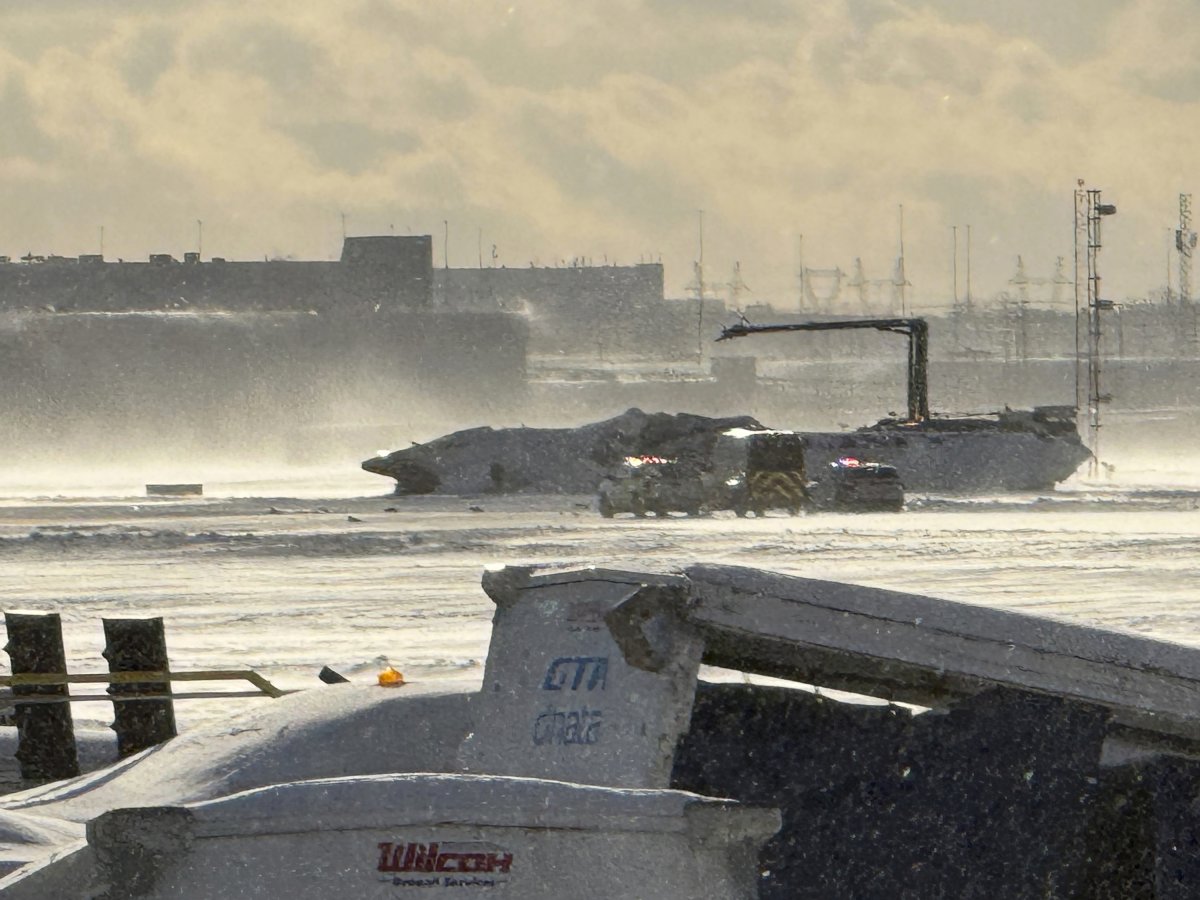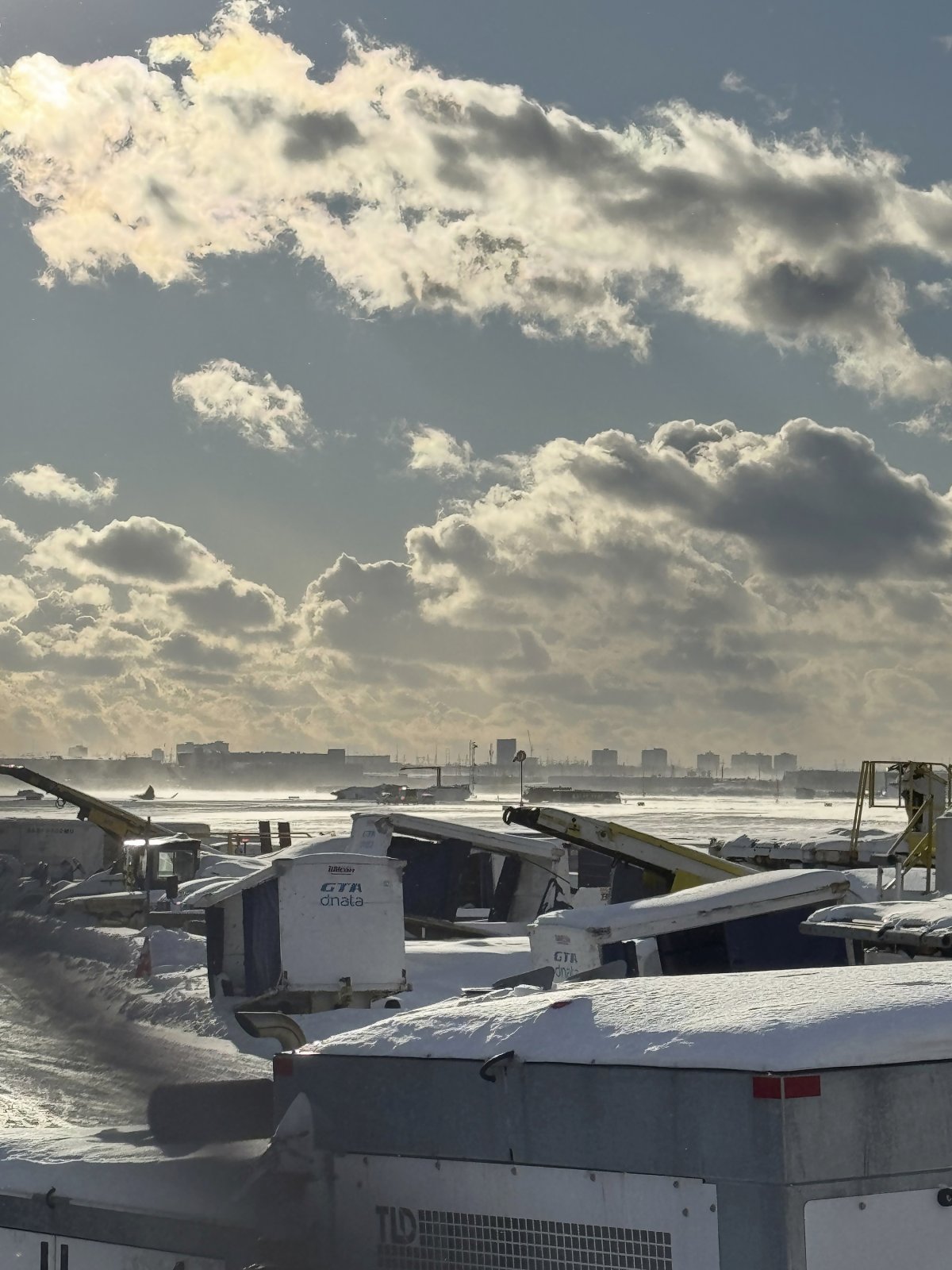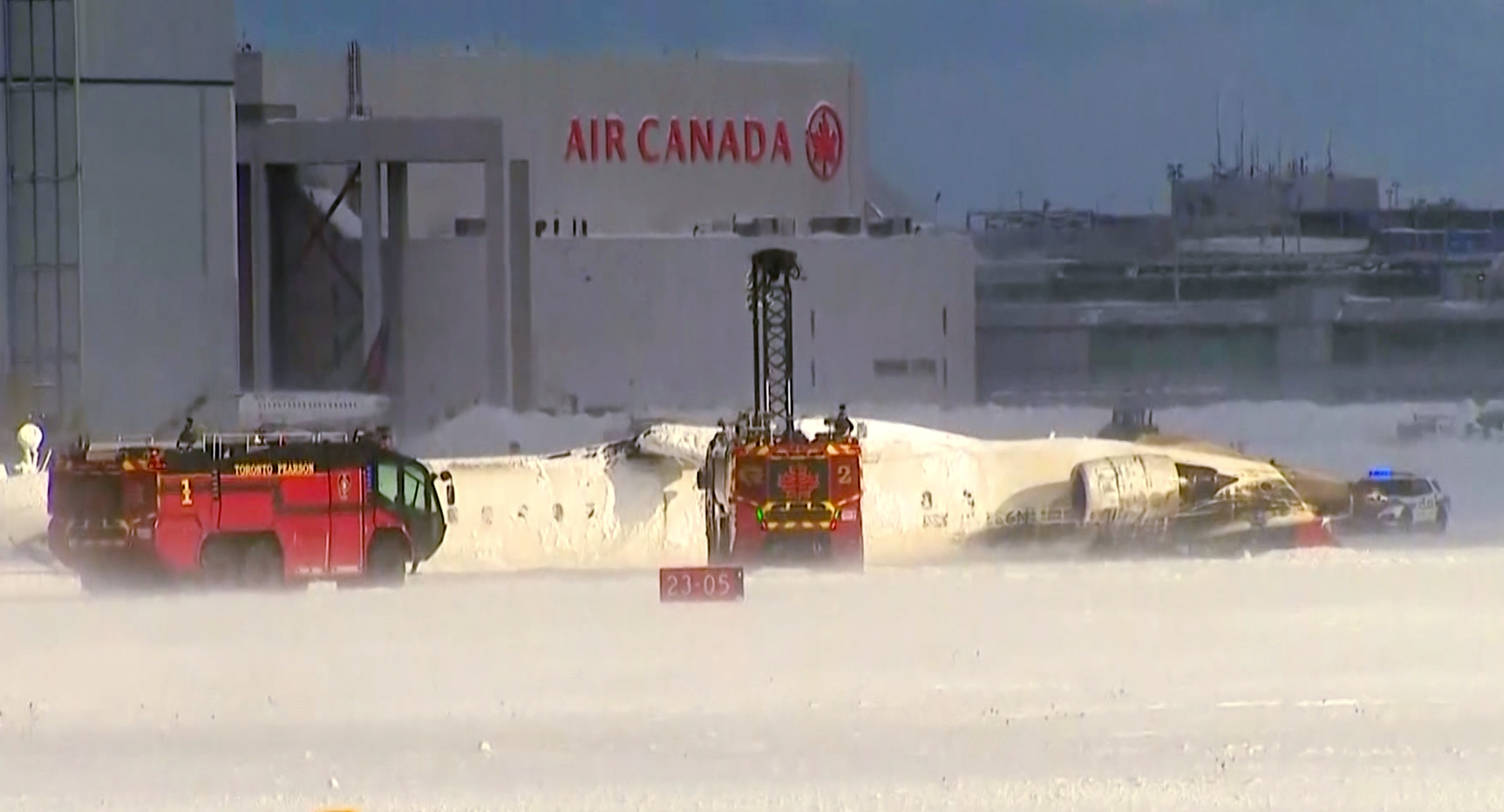A Delta Air Lines jet flipped onto its roof while landing Monday at Toronto Pearson Airport, but all 80 people on board survived, and those injured sustained relatively minor wounds, the airport's chief executive said.
Winds gusting up to 40 mph blew snow across the area as the flight from Minneapolis, carrying 76 passengers and four crew members, attempted to land on a dry runway around 2:15 p.m. Authorities said the cause of the crash is still under investigation.
Video posted on social media captured only the aftermath, showing the Mitsubishi CRJ-900LR overturned with its fuselage largely intact. Firefighters were seen extinguishing the remnants of a fire as passengers climbed out and walked across the tarmac.
"We are very grateful there was no loss of life and relatively minor injuries," Deborah Flint, CEO of Greater Toronto Airports Authority, told reporters.

The Context
This marks at least the fourth major aviation incident in North America in the past month. On January 29, a commercial jetliner and an Army helicopter collided near the nation's capital, claiming 67 lives. Two days later, on January 31, a medical transport plane crashed in Philadelphia, killing all six onboard and one person on the ground. Additionally, a plane crash on February 6 in Alaska resulted in 10 fatalities.
What To Know About Delta Flight 4819
Delta Flight 4819 departed Minneapolis, Minnesota, at 11:47 a.m. local time, cruising at 29,000 feet en route to Toronto Pearson Airport.
An audio recording from the control tower at Toronto Pearson International Airport reveals that the flight was cleared to land at approximately 2:10 p.m. local time. As the plane approached, the tower cautioned the pilots about a potential airflow disturbance in the glide path due to a preceding aircraft.
"It sounds to me like a controller trying to be helpful, meaning the wind is going to give you a bumpy ride coming down, that you're going to be up and down through the glide path," John Cox, CEO of aviation safety consulting firm Safety Operating Systems in St. Petersburg, Florida, told the Associated Press.
There was no further communication with the Delta flight until the tower confirmed that an aircraft had overturned upon landing in windy conditions following a snowstorm.
"Just so you're aware, there's people outside walking around the aircraft there," a tower controller said. "Yeah, we've got it. The aircraft is upside down and burning," the medical helicopter pilot responded.
It remains too early to determine what caused the plane to flip, though weather may have been a factor. The Meteorological Service of Canada reported blowing snow and winds at the airport reaching 32 mph, with gusts up to 40 mph. The temperature at the time was approximately 16.5 degrees.
"The weather conditions were windy. The wind was out of the west at 27 to 35 knots, which is about 38 miles an hour. So it was windy. But the airplanes are designed and certified to handle that. The pilots are trained and experienced to handle that," John Cox, CEO of aviation safety consulting firm Safety Operating Systems in St. Petersburg, Florida, told the Associated Press.
Passengers Recall Chaotic Landing
A video by John Nelson, an apparent passenger who evacuated the plane, posted to Facebook, shows emergency crews working around the plane.
"We're in Toronto. We just laned. Our plane crashed. It's upside down ... fire departments on site. Upside down. Most people appear to be OK," the passenger posted to Facebook.
Newsweek reached out to Nelson for comment.
Interviewed Monday night on CNN, he called the crash "mass chaos" as the plane "landed hard," skidded on the icy runway then flipped on its roof.
"I was just trying to hold on. It was mass chaos. I was upside down. The lady next to me was upside down," Nelson told CNN's Brianna Keilar. "We kind of let ourselves go and fell to the ceiling, which is a surreal feeling.
Another passenger, Pete Koukov, told Keilar he and the other passengers were hanging upside down "like bats" as the plane came to a stop on its roof.
"We hit the ground, and we were sideways, and then we were upside down hanging like bats," Koukov said. "Just feeling lucky and happy I got to give the person I didn't know sitting next to me a big hug, that we were okay."
Status of Toronto Pearson Airport
The crash temporarily grounded flights at Toronto Pearson Airport—the busiest airport in Canada—for approximately two and a half hours. Two runways will remain closed during the investigation.
The airport was expecting a "busy day" as it was coming out of back-to-back snowstorms, this weekend, a storm left over eight inches of snow. Toronto Pearson posted on X just four and a half hours prior to the crash that "the clean up continues from this weekend's storm." Crews worked throughout the weekend to "keep the roughly 5 million square metres of airfield clear of snow to keep planes arriving and departing safely."
What to Know About Endeavor Air
Minneapolis-based Endeavor Air, a subsidiary of Delta Air Lines, is the world's largest operator of CRJ-900 aircraft. According to the company's website, the airline operates 130 regional jets, conducting 700 daily flights to over 126 destinations across the U.S., Canada, and the Caribbean.
The CRJ-900, a widely used regional jet, was developed by Canadian aerospace company Bombardier. It belongs to the same aircraft family as the CRJ-700, the model involved in the midair collision near Reagan National Airport on Jan. 29.
Endeavor Air typically operates smaller planes. This plane had 76 seats, according to Cirium, an aviation data firm, as reported by The New York Times. The outlet also noted that the plane is about 16 years old, but aircrafts in its model typically last two to three decades.

What People Are Saying
The FAA told Newsweek via email: "The CRJ-900 departed Minneapolis/St. Paul International Airport. The Transportation Safety Board of Canada will be in charge of the investigation and will provide any updates."
Secretary of Transportation Sean Duffy said on X: "Update on Delta crash in Toronto: FAA investigators are en route to Toronto. The Transportation Safety Board of Canada will lead the investigation. I've been in touch with my counterpart in Canada to offer assistance and help with the investigation. More to follow."
Delta on X: "YYZ was closed shortly after the incident occurred. Delta is working to connect with customers traveling from, to or through YYZ who should also monitor the status of their flight via the Fly Delta app.
"Endeavor Air is a wholly owned subsidiary of Delta Air Lines headquartered in Minneapolis."
Ontario's Premier Doug Ford, who represents Toronto which is the capital of Ontario's province, on X: "I'm relieved there are no casualties after the incident at Toronto Pearson. Provincial officials are in contact with the airport and local authorities and will provide any help that's needed."
The Association of Flight Attendants on X: "Our union is responding to an incident in Toronto with Delta Air Lines Endeavor Flight 4819. AFA crew were working this flight. Reports are there are no fatalities. Please do not speculate on this incident as everyone works to gather information and support those involved."
Constable Sarah Patten of the Peel Regional Police in Ontario told Reuters: "There is a plane crash. However, we don't know the circumstances surrounding it at this point. It is my understanding that most of the passengers are out and unharmed but we're still trying to make sure so we're still on scene investigating."
What's Next
The Transportation Safety Board of Canada (TSB) told Newsweek via email that it is deploying a team of investigators following the crash. The TSB, an independent agency that investigates air, marine, pipeline, and rail transportation occurrences, said it will gather information and assess the incident.
This is a developing news story and will be updated as more information is available.
Reporting by the Associated Press contributed to this story.
Update: 2/17/25, 3:21 p.m. ET: This article has been updated with additional information.
Update: 2/17/25, 3:25 p.m. ET: This article has been updated with additional information.
Update: 2/17/25, 3:27 p.m. ET: This article has been updated with additional information.
Update: 2/17/25, 3:35 p.m. ET: This article has been updated with additional information.
Update: 2/17/25, 3:46 p.m. ET: This article has been updated with additional information.
Update: 2/17/25, 4:10 p.m. ET: This article has been updated with comments from the Association of Flight Attendants.
Update: 2/17/25, 4:32 p.m. ET: This article has been updated with comments from the Transportation Safety Board of Canada.
Update: 2/17/25, 4:47 p.m. ET: This article has been updated with additional information.
Update: 2/17/25, 5:25 p.m. ET: This article has been updated with additional information.
Update: 2/17/25, 5:53 p.m. ET: This article has been updated with additional information.
Update: 2/17/25, 7:15 p.m. ET: This article has been updated with additional information.
Update: 2/17/25, 8:06 p.m. ET: This article has been updated with additional information.
Update: 2/17/25, 9:20 p.m. ET: This article has been updated with additional information.
About the writer
Monica is a Newsweek reporter based in Boston. Her focus is reporting on breaking news. Monica joined Newsweek in 2024. ... Read more



